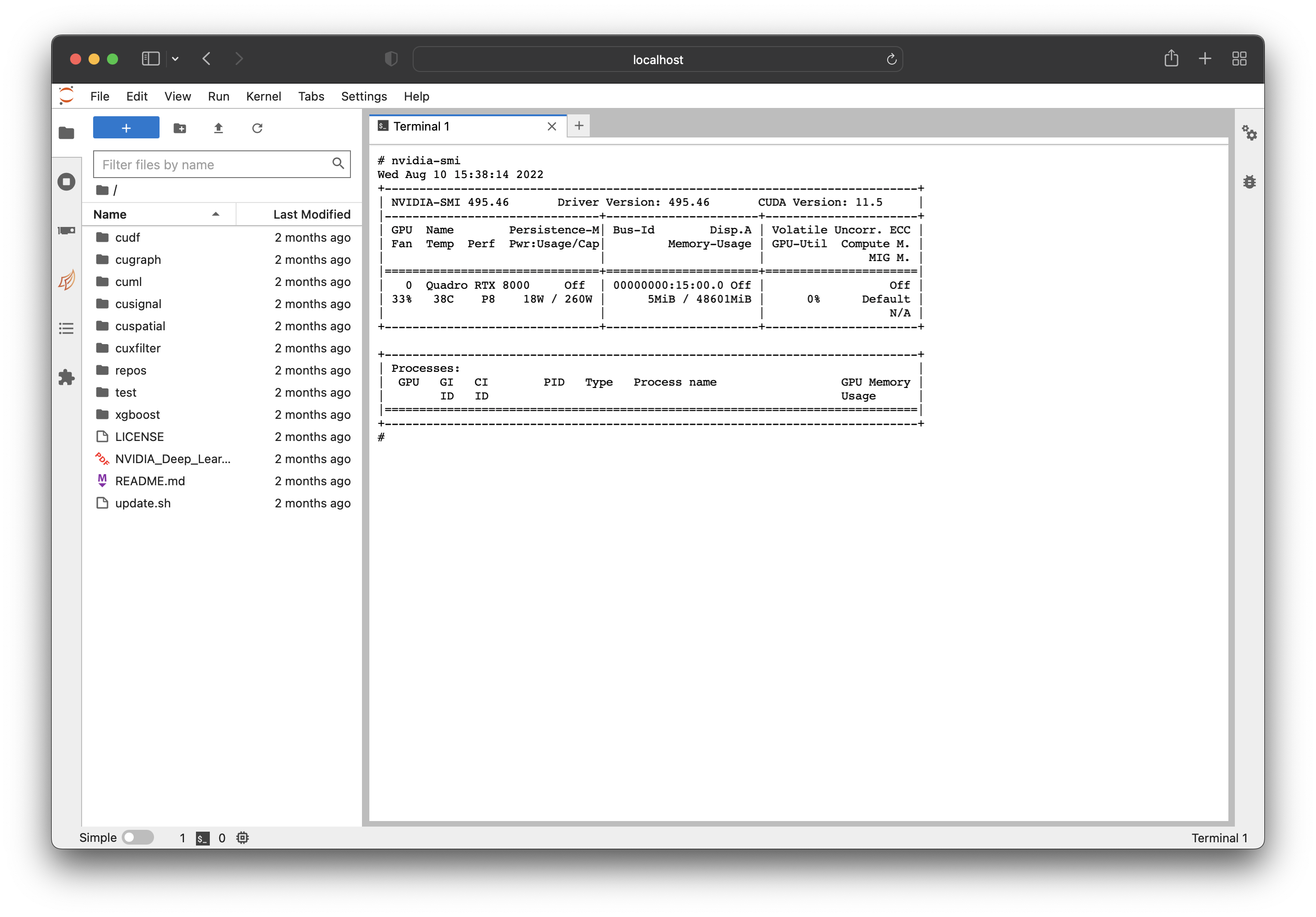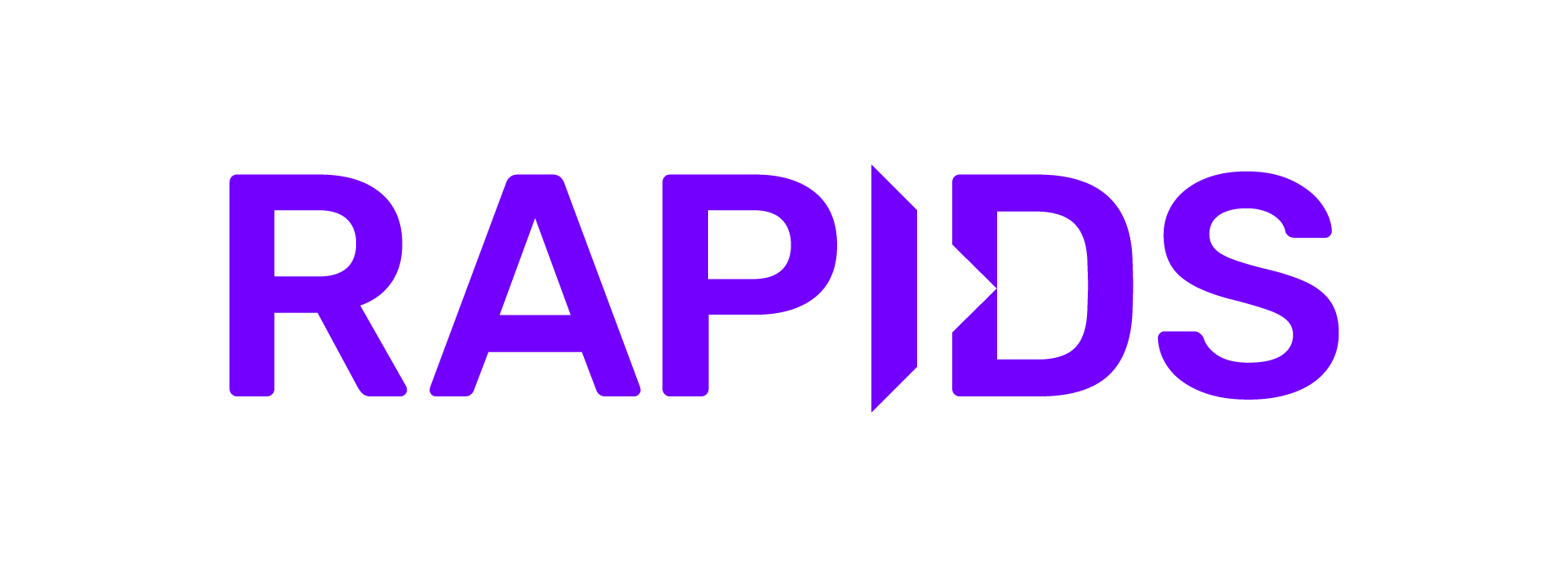Kubernetes#
RAPIDS integrates with Kubernetes in many ways depending on your use case.
Interactive Notebook#
For single-user interactive sessions you can run the RAPIDS docker image which contains a conda environment with the RAPIDS libraries and Jupyter for interactive use.
You can run this directly on Kubernetes as a Pod and expose Jupyter via a Service. For example:
# rapids-notebook.yaml
apiVersion: v1
kind: Service
metadata:
name: rapids-notebook
labels:
app: rapids-notebook
spec:
type: NodePort
ports:
- port: 8888
name: http
targetPort: 8888
nodePort: 30002
selector:
app: rapids-notebook
---
apiVersion: v1
kind: Pod
metadata:
name: rapids-notebook
labels:
app: rapids-notebook
spec:
securityContext:
fsGroup: 0
containers:
- name: rapids-notebook
image: "nvcr.io/nvidia/rapidsai/notebooks:24.06-cuda11.8-py3.10"
resources:
limits:
nvidia.com/gpu: 1
ports:
- containerPort: 8888
name: notebook
Optional: Extended notebook configuration to enable launching multi-node Dask clusters
Deploying an interactive single-user notebook can provide a great place to launch further resources. For example you could install dask-kubernetes and use the dask-operator to create multi-node Dask clusters from your notebooks.
To do this you’ll need to create a couple of extra resources when launching your notebook Pod.
Service account and role
To be able to interact with the Kubernetes API from within your notebook and create Dask resources you’ll need to create a service account with an attached role.
apiVersion: v1
kind: ServiceAccount
metadata:
name: rapids-dask
---
apiVersion: rbac.authorization.k8s.io/v1
kind: Role
metadata:
name: rapids-dask
rules:
- apiGroups: [""]
resources: ["pods", "services"]
verbs: ["get", "list", "watch", "create", "delete"]
- apiGroups: [""]
resources: ["pods/log"]
verbs: ["get", "list"]
- apiGroups: [kubernetes.dask.org]
resources: ["*"]
verbs: ["*"]
---
apiVersion: rbac.authorization.k8s.io/v1
kind: RoleBinding
metadata:
name: rapids-dask
roleRef:
apiGroup: rbac.authorization.k8s.io
kind: Role
name: rapids-dask
subjects:
- kind: ServiceAccount
name: rapids-dask
Then you need to augment the Pod spec above with a reference to this service account.
apiVersion: v1
kind: Pod
metadata:
name: rapids-notebook
labels:
app: rapids-notebook
spec:
serviceAccountName: rapids-dask
...
Proxying the Dask dashboard and other services
The RAPIDS container comes with the jupyter-server-proxy plugin preinstalled which you can use to access other services running in your notebook via the Jupyter URL. However, by default this is restricted to only proxying services running within your Jupyter Pod. To access other resources like Dask clusters that have been launched in the Kubernetes cluster we need to configure Jupyter to allow this.
First we create a ConfigMap with our configuration file.
apiVersion: v1
kind: ConfigMap
metadata:
name: jupyter-server-proxy-config
data:
jupyter_server_config.py: |
c.ServerProxy.host_allowlist = lambda app, host: True
Then we further modify out Pod spec to mount in this config map to the right location.
apiVersion: v1
kind: Pod
...
spec:
containers
- name: rapids-notebook
...
volumeMounts:
- name: jupyter-server-proxy-config
mountPath: /root/.jupyter/jupyter_server_config.py
subPath: jupyter_server_config.py
volumes:
- name: jupyter-server-proxy-config
configMap:
name: jupyter-server-proxy-config
We also might want to configure Dask to know where to look for the Dashboard via the proxied URL. We can set this via an environment variable in our Pod.
apiVersion: v1
kind: Pod
...
spec:
containers
- name: rapids-notebook
...
env:
- name: DASK_DISTRIBUTED__DASHBOARD__LINK
value: "/proxy/{host}:{port}/status"
Putting it all together
Here’s an extended rapids-notebook.yaml spec putting all of this together.
# rapids-notebook.yaml (extended)
apiVersion: v1
kind: ServiceAccount
metadata:
name: rapids-dask
---
apiVersion: rbac.authorization.k8s.io/v1
kind: Role
metadata:
name: rapids-dask
rules:
- apiGroups: [""]
resources: ["pods", "services"]
verbs: ["get", "list", "watch", "create", "delete"]
- apiGroups: [""]
resources: ["pods/log"]
verbs: ["get", "list"]
- apiGroups: [kubernetes.dask.org]
resources: ["*"]
verbs: ["*"]
---
apiVersion: rbac.authorization.k8s.io/v1
kind: RoleBinding
metadata:
name: rapids-dask
roleRef:
apiGroup: rbac.authorization.k8s.io
kind: Role
name: rapids-dask
subjects:
- kind: ServiceAccount
name: rapids-dask
---
apiVersion: v1
kind: ConfigMap
metadata:
name: jupyter-server-proxy-config
data:
jupyter_server_config.py: |
c.ServerProxy.host_allowlist = lambda app, host: True
---
apiVersion: v1
kind: Service
metadata:
name: rapids-notebook
labels:
app: rapids-notebook
spec:
type: ClusterIP
ports:
- port: 8888
name: http
targetPort: notebook
selector:
app: rapids-notebook
---
apiVersion: v1
kind: Pod
metadata:
name: rapids-notebook
labels:
app: rapids-notebook
spec:
serviceAccountName: rapids-dask
securityContext:
fsGroup: 0
containers:
- name: rapids-notebook
image: nvcr.io/nvidia/rapidsai/notebooks:24.06-cuda11.8-py3.10
resources:
limits:
nvidia.com/gpu: 1
ports:
- containerPort: 8888
name: notebook
env:
- name: DASK_DISTRIBUTED__DASHBOARD__LINK
value: "/proxy/{host}:{port}/status"
volumeMounts:
- name: jupyter-server-proxy-config
mountPath: /root/.jupyter/jupyter_server_config.py
subPath: jupyter_server_config.py
volumes:
- name: jupyter-server-proxy-config
configMap:
name: jupyter-server-proxy-config
$ kubectl apply -f rapids-notebook.yaml
This makes Jupyter accessible on port 30002 of your Kubernetes nodes via NodePort service. Alternatvely you could use a LoadBalancer service type if you have one configured or a ClusterIP and use kubectl to port forward the port locally and access it that way.
$ kubectl port-forward service/rapids-notebook 8888
Then you can open port 8888 in your browser to access Jupyter and use RAPIDS.

Dask Operator#
Dask has an operator that empowers users to create Dask clusters as native Kubernetes resources. This is useful for creating, scaling and removing Dask clusters dynamically and in a flexible way. Usually this is used in conjunction with an interactive session such as the interactive notebook example above or from another service like KubeFlow Notebooks. By dynamically launching Dask clusters configured to use RAPIDS on Kubernetes user’s can burst beyond their notebook session to many GPUs spreak across many nodes.
Find out more on the Dask Operator page.
Helm Chart#
Individual users can also install the Dask Helm Chart which provides a Pod running Jupyter alongside a Dask cluster consisting of pods running the Dask scheduler and worker components. You can customize this helm chart to run the RAPIDS container images as both the notebook server and Dask cluster components so that everything can benefit from GPU acceleration.
Find out more on the Dask Helm Chart page.
Dask Gateway#
Some organisations may want to provide Dask cluster provisioning as a central service where users are abstracted from the underlying platform like Kubernetes. This can be useful for reducing user permissions, limiting resources that users can consume and exposing things in a centralised way. For this you can deploy Dask Gateway which provides a server that users interact with programatically and in turn launches Dask clusters on Kubernetes and proxies the connection back to the user.
Users can configure what they want their Dask cluster to look like so it is possible to utilize GPUs and RAPIDS for an accelerated cluster.
KubeFlow#
If you are using KubeFlow you can integrate RAPIDS right away by using the RAPIDS container images within notebooks and pipelines and by using the Dask Operator to launch GPU accelerated Dask clusters.
Find out more on the KubeFlow page.
